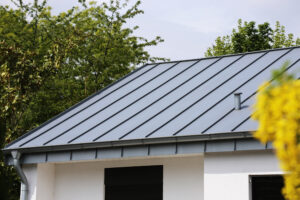Is a Metal Roof Cheaper than Shingles? The Real Cost Comparison

When it comes to your roof, you want an option that is affordable yet durable. Asphalt shingles have been the go-to roofing material for decades thanks to their low upfront cost. But metal roofs have surged in popularity in recent years as homeowners learn of their long-term value.
So when considering whether to go with shingles versus metal roofing, the key question is: which actually costs less in the long run?
1. Upfront Cost Differences
On average, a metal roof costs $6-12 per square foot installed compared to $3-7 per square foot for most asphalt shingles. There are premium architectural shingles that run $7-10 per square foot but offer better durability than the baseline options.
Clearly metal roofing requires a higher initial investment. A 30-square (3,000 sq.ft) roof would run around $12,000-18,000 for metal compared to $9,000-21,000 for shingles.
2. Lifespan Differences
But metal roofs have an exceptionally longer lifespan —generally 2-3 times longer than asphalt. Most steel or aluminum roofs last 40-70 years, while most shingles last 12-25 years before needing full replacement (premium architectural shingles may last 35+ years).
So while metal roofing costs more upfront, fewer re-roofings are needed over the years.
Let’s break down cost over a 60-year period on that same 3,000 sq.ft. roof:
Asphalt Shingles:
- Installs: 3 (every 20 years at $21,000 per install)
- Cost over 60 years = $63,000
Metal roof:
- Installs: 1 (lasting 60+ years at $18,000)
- Cost over 60 years = $18,000
Measured this way, metal roofing can save tens of thousands over the lifetime of your home!
3. Energy Efficiency and Durability
There is also the energy efficiency factor of metal roofs to consider. Their reflective properties result in a cooler attic and lower air conditioning bills in warm climates. These savings over 20-30 years can amount to thousands.
Durability also sets metal roofs apart. While hail storms or falling branches can easily damage asphalt shingles, most metal roofs brush off the impact while staying watertight. Home insurance discounts are common for houses with metal roofing thanks to their resilience. Any discount amount further tips cost-effectiveness scales towards metal roofing.
4. Installation Considerations
On many homes, installing metal roofing is a bigger job. It often requires plywood decking material, additional framing, and closer attention to detail around flashing and roof penetrations like vents. Combined with higher material costs, this substantial labor expense is why metal roof installation runs 50-100% more than shingles.
But for simple, sloped ranch homes or bungalow styles with clean lines, metal roofing may only be moderately more difficult to install than asphalt, somewhat lessening the upcharge.
5. Getting the Right Combination of Affordability and Quality
In the roofing world, there is truth to the old adage “you get what you pay for”. While inexpensive at the outset, replacing shingle roofs every couple decades is no small expense either when you add it up.
Opting for a quality standing seam metal roof might cost you more today, but it frees you from the endless cycle of re-roofing while saving energy and providing peace of mind that your home and belongings stay protected in harsh weather.
Like your wise old grandpa probably said, “You’re never actually saving money if you have to keep buying the same cheap thing over and over again”. In roofing, that cheap thing is asphalt shingles.
Yes, metal does cost more upfront. But minor energy bill savings and huge lifecycle savings make it very economical long-term. Lower repair costs and better curb appeal don’t hurt either.
So while metal roofing requires more thought and planning, for most homes, the choice is clear if you intend to stay put for 20+ years. Think of the long game, opt for quality, and choose metal over shingles.

Meet Sarah Johnson, an expert writer specializing in solar, bath remodel, windows, and roofing. She is passionate about sustainable living and combines technical knowledge with engaging writing, providing clear insights into the home improvement space. With a background in journalism, Sarah is a trusted voice empowering homeowners to make informed decisions for structural integrity and energy efficiency, inspiring a more sustainable lifestyle.
